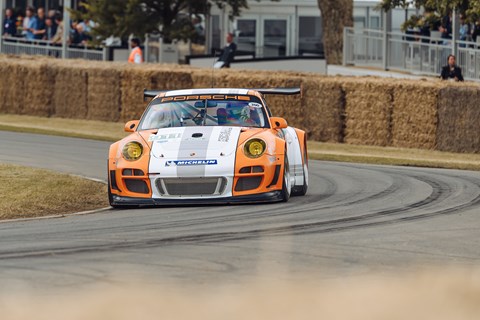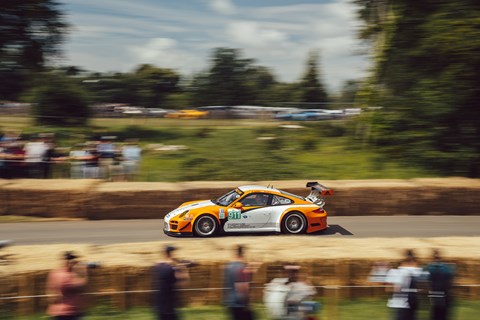► Porsche’s first attempt at adding hybrid to the 911
► 4.0-litre flat-six drives the rear wheels…
► …while two 60kW electric motors power the fronts
As is usually the case at the start of the Goodwood hillclimb, I’m a touch apprehensive. A Porsche 911 racing car would be more than enough to focus my mind, but the nice men from Porsche’s Museum have brought something even more special to the Festival of Speed this year. Namely, the ultra-rare Porsche 911 GT3 R Hybrid.
For those wondering why they never saw it racing in the early 2010s, its appearances were few and far between. Having said that the GT3 R Hybrid would have won the 2010 Nurburgring 24hr were it not for a late mechanical failure, but gaining trophies was not the primary purpose of this car.
Rather, it was created as a test mule for exploration into the possible use of hybrid powertrains in motorsport and, eventually, on road cars. Fast forward a decade and a half and Porsche’s competitive record with its 919 Hybrid is formidable and includes three World Endurance Championship constructor’s titles and three outright wins at the 24 Hours of Le Mans.

In short, then, the data gained from the 911 GT3 R Hybrid helped to deliver a golden age in Porsche motorsport and no doubt contributed, even if indirectly, to the latest road-going hybrid 911. But what is it like as an actual racing car?
Flipping incredible, is the answer. It takes a bit of *ahem* persuasion to get it off the line, but once rolling it feels like a 911 GT3 with the noise, vibrations and speed turned up to 11. There’s around 480bhp from the ICE, yet together with the two 60kW electric motors you’re looking at over 600bhp.
The system works by harvesting energy generated under braking, storing it in a flywheel that spins at up to 40,000rpm (yep, there’s no battery) and then deploying said energy in several-second bursts to improve straight line speed and cut lap times. Of course, there’s a weight penalty – around 150kg – and on track that means that the regular GT3 R is often quicker over a single lap, but the reduced fuel consumption has huge benefits in endurance racing – hence nearly winning the N24h in 2010.

I will let you into a little secret, however. Today, the electric motors aren’t linked up, so we’re just running in pure ICE mode. Am I thinking about this as I’m screaming past Goodwood House on my left, furiously scanning the road ahead for my braking point into Molecomb? Absolutely not.
The experience aboard the GT3 R Hybrid does not appear to be in any way diminished with the lack of e-motors. Running up the narrow Goodwood driveway, 480bhp in a circa 1.3-tonne car feels more than ample, yet there’s brilliant feel through all major controls. The steering is light but accurate, the driving position perfect and the brake pedal fills you with confidence going into the slower corners.

To keep things as stable as possible, we’re on wet tyres but even so the movement from the tread blocks creates small amounts of slip across the road surface. Nothing the GT3 R Hybrid can’t handle, but eye-opening nonetheless.
Screaming up the finish straight towards the holding area, the sound of that flat-six engine will be my last memory. Frantic, yet so sweet on the ears, the whine from the transmission lines every pull through the rev range and makes the sound all the more unique. It’s unmistakeable and addictive, loud and uncompromising. What a machine.
Photography by Dan Bathie and Mark Riccioni